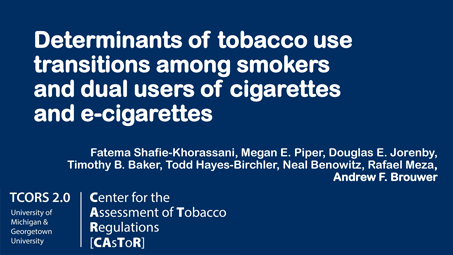“Determinants of tobacco use transitions among smokers and dual users of cigarettes and e-cigarettes” with Dr. Andrew Brouwer (University of Michigan)
- Contact the presenter
- Dr. Andrew Brouwer <brouweaf@umich.edu>
- View Abstract +
- INTRODUCTION: The introduction of e-cigarettes has dramatically changed the landscape of tobacco products and product-use patterns in the US. Although e-cigarettes have the potential to promote smoking cessation, their real-world impact remains uncertain. A systems approach can help to understand transitions between different patterns of tobacco and nicotine product use. METHODS: The aims of this project were to leverage frequent follow-up data from the University of Wisconsin Center for Tobacco Research and Intervention’s Exhale cohort of cigarette users and dual users of cigarettes and e-cigarettes (2015-2017) to 1) determine how transition rates between cigarette and e-cigarette use depend on sociodemographic, smoking behavior, smoking dependence, and smoking biomarker measures as well as 2) time since one’s last transition. A supplementary aim was to develop a continuous spline estimator to facilitate estimation of the impact of continuous variables on transitions. In this project, we leveraged a multistate transition model, which is a type of continuous-time Markov chain model, to estimate the underlying transition hazard rates that collectively inform observed transition patterns as well as hazard ratios (HRs) comparing subgroups. RESULTS: In this cohort, dual users were more likely to quit smoking than cigarette-only users, but the overall impact was small because most dual users returned to cigarette-only use. Moreover, e-cigarette dependence promoted continued dual use rather than smoking cessation. E-cigarette users motivated by harm or toxicity reduction or because of restrictions on where or when they could smoke had reduced rates of smoking relapse. Cigarette dependence and spousal smoking were barriers to cigarette cessation for dual users, while using e-cigarettes first in the morning, motivation to quit smoking, and sensory, social, and emotional enjoyment of e-cigarettes (secondary dependence motives) were facilitators of smoking cessation among dual users. The longer participants remained cigarette-only or dual users, the lower their propensity to transition to the other patterns of use, stabilizing around 8-12 months post-transition. IMPLICATIONS: Ultimately, a better understanding of the barriers and facilitators of transitions can help to develop regulations and interventions that lead to more effective use of e-cigarettes for smoking cessation. ACCOMPLISHMENTS: Dr. Brouwer was co-author on an article resulting from his pilot project work. The article, published in Nicotine & Tobacco Research, is entitled “Associations of demographics, dependence, and biomarkers with transitions in tobacco product use in a cohort of cigarette users and dual users of cigarettes and e-cigarettes” and is available here. This project also supported, in part, one published paper, one submitted paper, and one paper in preparation; four conference posters; several webinars and an instructional workshop; a U54 center renewal proposal; and a planned R21 proposal submission.
- View Bio +
- Dr. Andrew Brouwer is a computational epidemiologist and modeler. He is an Assistant Research Scientist in the Department of Epidemiology at the University of Michigan. He earned his PhD in Applied and Interdisciplinary Mathematics at the University of Michigan in 2015, and he also holds an MA in Statistics and an MS Environmental Science and Engineering. Dr. Brouwer’s research focuses on mathematical and statistical modeling for inference in epidemiology, with the goal of making the most of dynamic data for the benefit of public health. He is an expert in methods that address questions of parameter identifiability, estimation, and uncertainty. Informed by his interdisciplinary background, his research spans a growing constellation of application areas including infectious disease, cancer, and tobacco control. Though these areas may seem disparate at first glance, Dr. Brouwer’s work is united by the use of mechanistic frameworks as a lens to interpret real data, a focus on longitudinal patterns and dynamics, and by a quantitative toolset that includes differential equation models, multistate transition models, and age–period–cohort models, among others. Dr. Brouwer’s profile at University of Michigan.
 Dr. Andrew BrouwerUniversity of Michigan
Dr. Andrew BrouwerUniversity of Michigan
